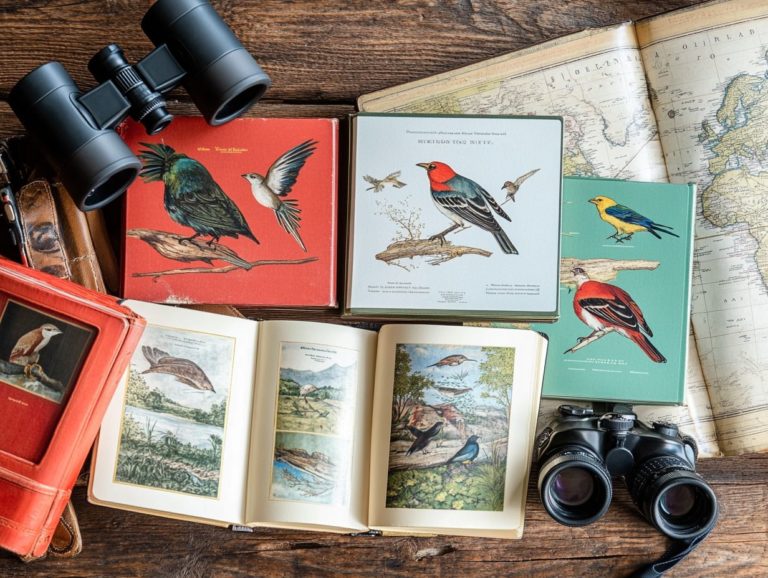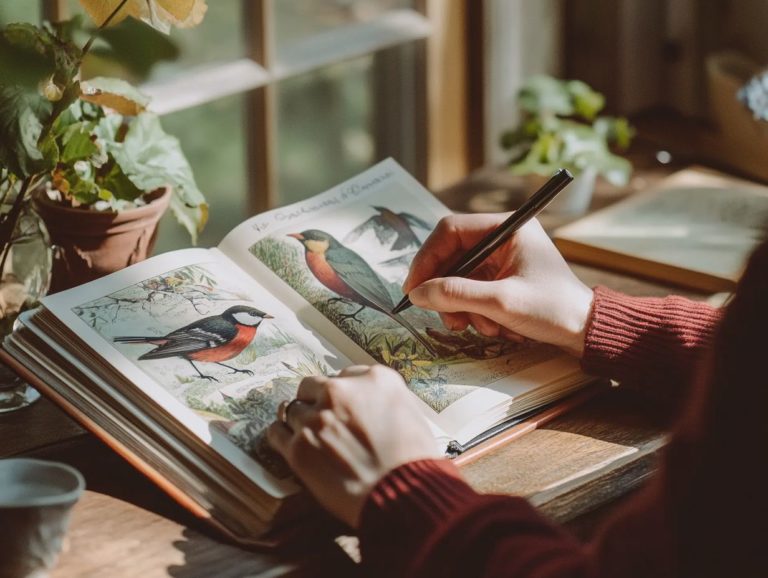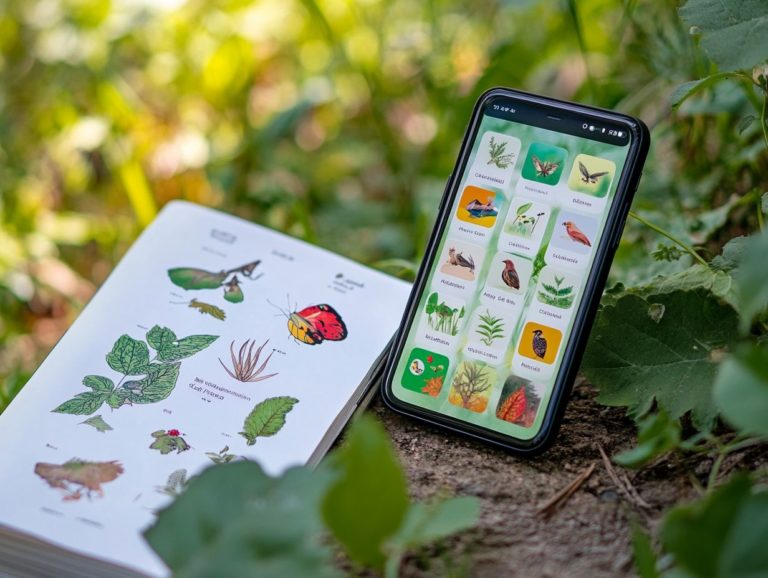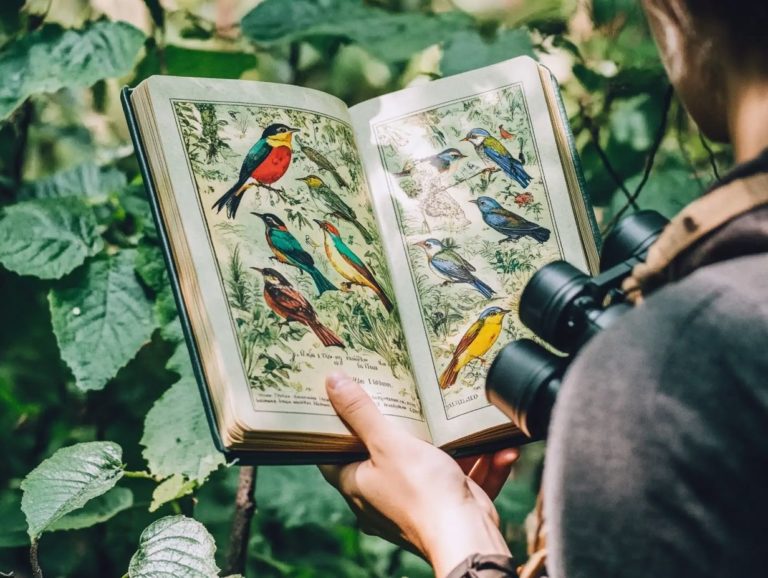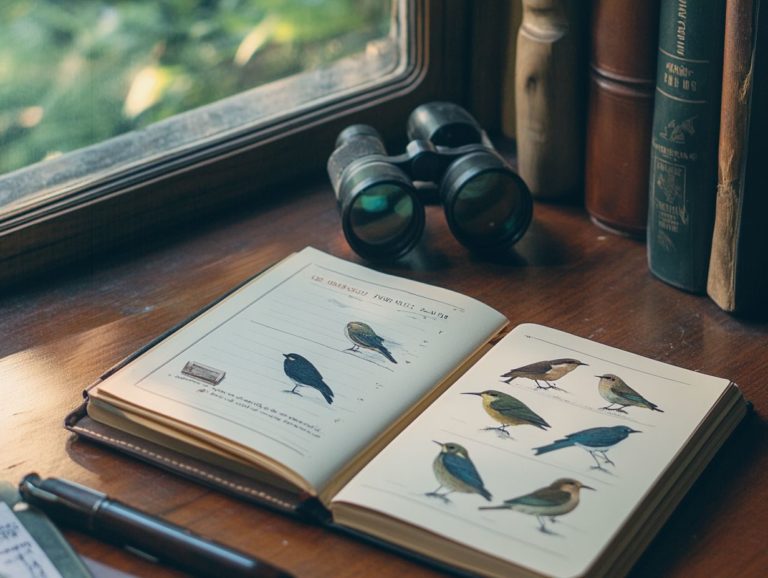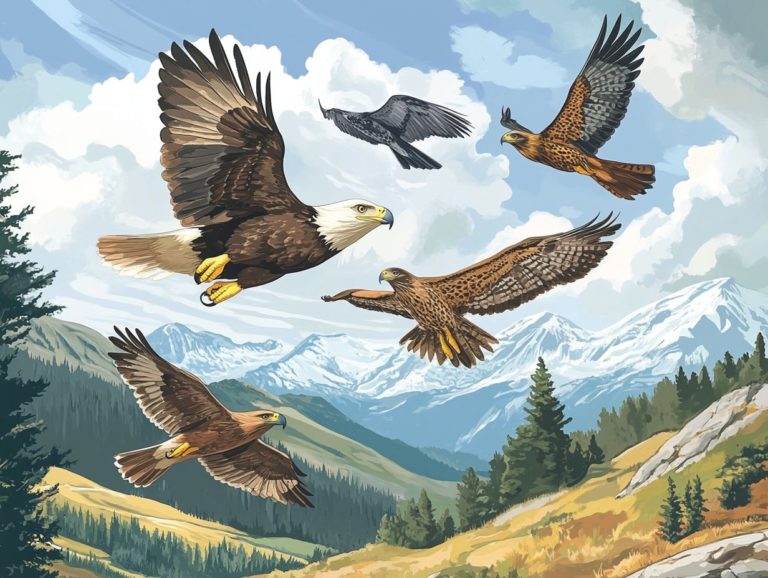Field Guides for Attracting Backyard Birds
Birdwatching in your backyard can transform your outdoor space.
It becomes a vibrant haven brimming with life and color.
This guide delves into the essentials of attracting birds, from selecting the perfect Sibley Field Guide to recognizing the common species that grace your garden.
You ll uncover essential tips for birding, setting up food feeders, and crafting a welcoming environment through intentional landscaping.
Moreover, you ll discover tools and techniques for observing and documenting your feathered visitors. Get ready to enrich your backyard experience and forge a deeper connection with nature!
Contents
- Key Takeaways:
- Benefits and Basics of Attracting Birds to Your Backyard
- Choosing the Right Field Guide
- Identifying Common Backyard Birds
- Attracting Birds with Feeders and Food
- Creating a Bird-Friendly Backyard
- Observing and Documenting Backyard Birds
- Frequently Asked Questions
- What are field guides for attracting backyard birds?
- Why should I use a field guide for attracting backyard birds?
- What should I look for in a field guide for attracting backyard birds?
- How can I use a field guide to attract specific bird species to my backyard?
- Are there any other resources I can use in addition to a field guide for attracting backyard birds?
- Do I need a lot of experience to use a field guide for attracting backyard birds?
Key Takeaways:
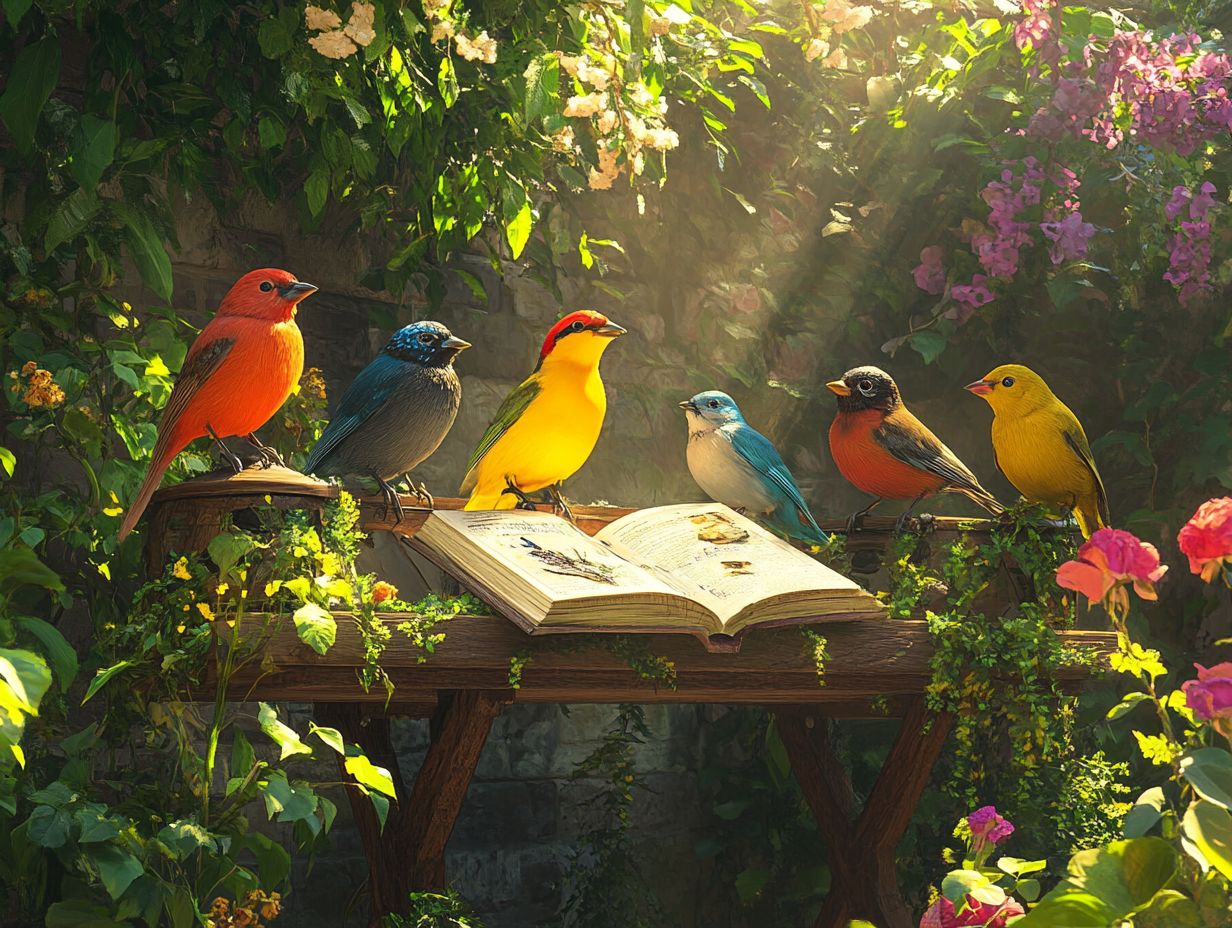
- Attracting backyard birds brings numerous benefits, including pest control and natural beauty.
- When choosing a Sibley Field Guide, consider features such as ease of use and comprehensive information.
- Identifying birds accurately can be achieved through observing physical characteristics and behaviors.
Benefits and Basics of Attracting Birds to Your Backyard
Attracting birds to your backyard isn t just a rewarding pursuit for bird enthusiasts; it also plays a vital role in fostering local conservation efforts. By cultivating an inviting habitat, you can revel in the beauty of backyard birds while actively contributing to the health of local ecosystems.
Whether you re a seasoned bird enthusiast or just embarking on your backyard birding journey, mastering essential tips to attract your neighborhood birds can turn your outdoor space into a lively wildlife and birdwatching sanctuary. This captivating hobby enhances your connection with nature and provides you with stunning images and unforgettable moments to share with family and friends.
Choosing the Right Field Guide
Selecting the right Backyard Bird Lover’s Field Guide is vital for bird enthusiasts eager to elevate their birding tips and accurately identify local species. A comprehensive guide, such as Sibley Field Guide, offers essential insights into various species, field marks, and even the unique personalities of the birds. For those birdwatching in urban areas, field guides for bird watching in urban areas can be an invaluable resource, whether you’re a novice or a seasoned birdwatcher.
Engaging with programs like the Audubon initiative provides further resources for mastering bird identification techniques. You can also gain insights from experts like Dena Temple and Eric Carlson, helping you effectively build your life list a record of all the bird species you’ve seen and deepen your appreciation for the world of birds.
Features to Consider
When selecting a field guide, consider features like clear visual identification tools, detailed species accounts, and essential information on local birds to elevate your birding experience. A quality field guide should offer beautiful images and descriptions that allow you to easily identify common backyard birds, such as the Carolina Wren and Ruby-throated Hummingbird or Red-tailed Hawk and Northern Mockingbird.
Pay attention to user-friendly layouts that provide quick access to information; this can significantly enhance your ability to identify birds efficiently.
Incorporating maps that illustrate the geographical distribution of different species can add considerable value to the guide. Effective field guides often share insights on understanding identification tips and bird personalities, enriching your interactions while observing them in their natural habitats.
Look for guides that provide seasonal insights and birding courses or migratory patterns and feeding stations, as this context can help you anticipate which birds you might encounter throughout the year. A great field guide becomes your trusted companion, helping you appreciate the wonders of birdlife.
Identifying Common Backyard Birds
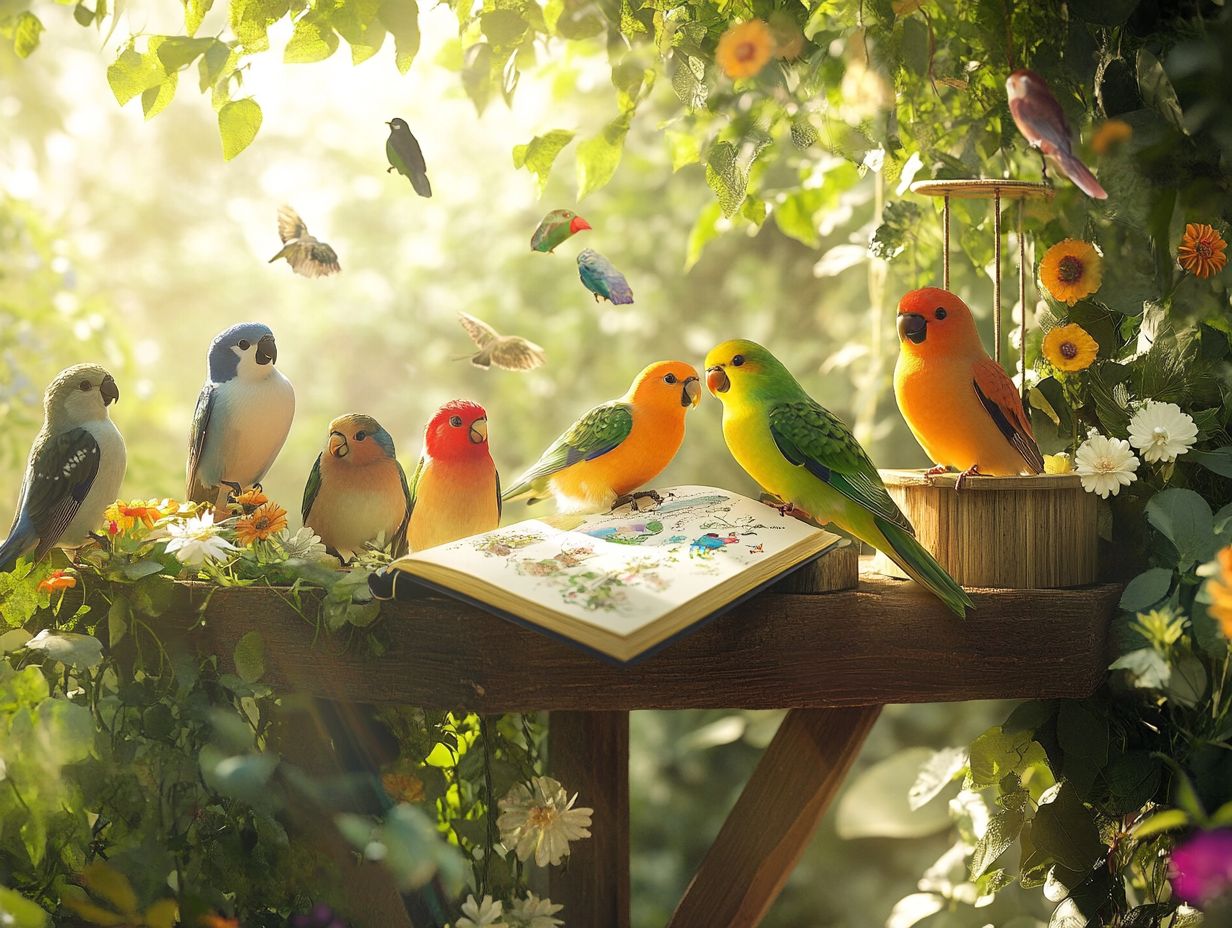
Identifying common backyard birds adds a thrilling dimension to your birding experience. It deepens your appreciation for local wildlife.
With a diverse array of species like the Carolina Wren, Red-tailed Hawk, Cedar Waxwing, and Gray Catbird visiting your feeding stations and bird feeders, familiarizing yourself with their distinct characteristics is essential.
By employing identification tips such as paying attention to distinct features, colors, and even the unique personalities of the birds, you can significantly elevate your birdwatching skills. This will transform your backyard into a vibrant haven for these feathered friends.
Tips for Accurate Identification
Accurate identification of birds is essential for effective birdwatching. You can enhance your skills with specific tips and techniques.
Take notes on bird behavior, colors, and field marks while utilizing binoculars, which help you see distant birds clearly. Engaging with apps or resources that offer sound recognition will aid in identifying local birds.
Understanding the habitat preferences of different species is very helpful. Consider factors such as location, time of year, and time of day, as these can influence bird activity and visibility.
Patience is crucial! Sometimes, simply waiting quietly for a bird to appear can lead to rewarding sightings.
Don t forget your field guide and journal! They ll help you track your progress over time and enhance your observational skills.
With regular practice and keen observation, you ll learn to recognize subtle differences. This will make bird identification a more enjoyable and fruitful pursuit.
Attracting Birds with Feeders and Food
Attracting birds to your backyard is an art! It starts with selecting the right bird feeders and food types.
Different species have distinct preferences. For instance, sunflower seeds are a favorite for many backyard birds, while hummingbirds are drawn to nectar feeders.
Incorporating squirrel-proof feeders can ensure your feeding stations remain a haven for birds. This keeps those pesky squirrels at bay.
By understanding the nutritional needs of these feathered friends and offering a diverse array of food options, you can create a lively and inviting environment. Transform your space into a birdwatcher’s paradise!
Types of Feeders and Foods to Use
When choosing feeders and foods to attract birds, grasp the preferences of your local visitors. You ll find various food feeders at your disposal.
Seed feeders can be filled with mixed seeds or sunflower seeds to draw in a delightful mix of species. If you want to welcome enchanting hummingbirds, nectar feeders are a must!
By catering to the specific feeding habits of different birds, you can elevate your birdwatching experience. This will increase the variety of species gracing your yard.
Suet feeders are particularly effective for luring in woodpeckers, nuthatches, and other birds that thrive on high-energy fat sources, especially during the chillier months.
Platform feeders are a versatile choice, perfect for scattering seeds and fruits. This allows sparrows and jays to feast in comfort.
Don’t overlook specialized options, like oriole feeders equipped with orange halves and jelly. These are sure to attract vibrant birds during migration season!
Ultimately, understanding these unique preferences will create a lively and diverse bird population that enhances the beauty of your outdoor space.
Creating a Bird-Friendly Backyard
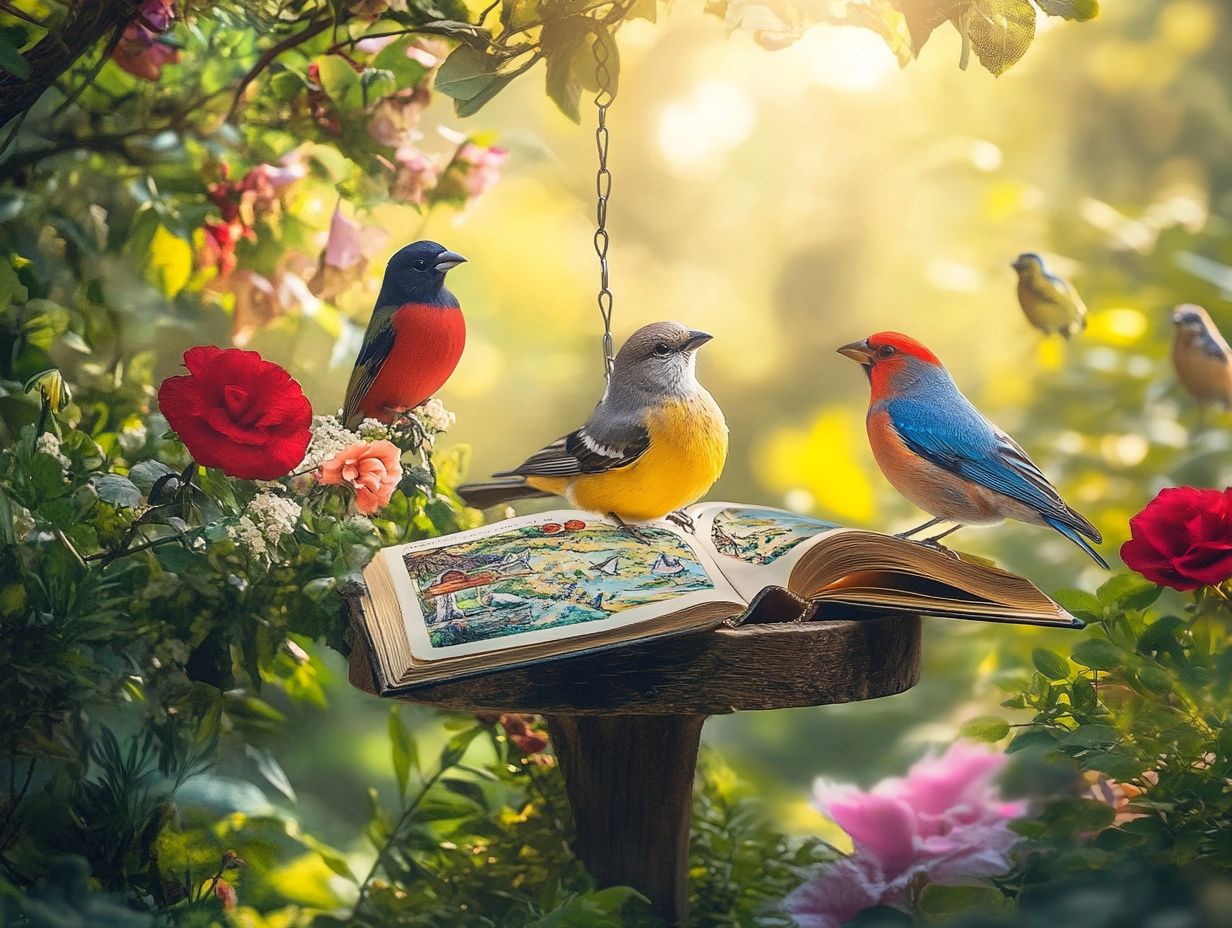
Creating a bird-friendly backyard means fostering an environment that caters to the diverse needs of local birds while nurturing a care for the environment.
When you incorporate native plants into your landscaping, you not only offer essential food and shelter for your backyard avian visitors but also enhance local biodiversity.
Enrich your outdoor space with bird baths, feeders, and natural habitats. This creates a sanctuary that supports wildlife and elevates your passion for birdwatching.
Planting and Landscaping Tips
When planning your landscaping, consider using native plants that provide food and shelter. These plants are vital for conserving the ecosystem, attracting pollinators, and balancing the habitat for visiting birds.
Select a variety of plants that bloom at different times of the year to ensure a continuous food source. This transforms your outdoor space into an inviting haven for wildlife.
Choosing native plants allows them to thrive with minimal maintenance and water, leading to a more sustainable garden. Look for species that produce berries, seeds, and nectar, as these are appealing to many birds.
When arranging your plants, place taller species at the back, mid-height plants in the middle, and shorter ones at the front. This creates shelter and foraging opportunities for your avian friends.
Add features like birdbaths and feeders to enhance the landscape and attract more feathered visitors, further enriching your backyard sanctuary.
Observing and Documenting Backyard Birds
Observing and documenting backyard birds, such as the Carolina Wren and Red-tailed Hawk, is a rewarding aspect of birdwatching. It helps you forge a deep connection with nature. By using the right tools like quality binoculars for identifying species such as the Cedar Waxwing and a well-kept birding journal for enthusiasts you can capture the vibrant essence of local birds and their feeding preferences.
This engaging hobby fosters mindfulness and an appreciation for wildlife conservation. It also inspires you to document stunning images and notes about the behaviors of local birds, enriching your overall experience in unexpected ways.
Start your journey toward creating a bird-friendly backyard today!
Tools and Techniques for Bird Watching
Birdwatching is an exciting hobby. The right tools can make your experience even better. Binoculars are critical for visual identification, enabling you to observe birds from a comfortable distance without causing any disturbance.
Using apps or field journals lets you carefully keep track of your sightings, behaviors, and even capture stunning images, enriching your engagement with this rewarding hobby.
A reliable field guide, such as The Sibley Field Guide, is essential for identifying various species. It gives you the power to swiftly identify them and gain insights into their habitats and behaviors. Audio recorders can also be a game changer, allowing you to capture bird calls and songs for later analysis, which can significantly improve your identification skills.
Participating in local birdwatching communities provides a platform to share experiences and tips. Such clubs often focus on conservation and backyard activities, opening the door to field trips that can greatly broaden your knowledge and observational prowess.
Together, these tools and techniques create a comprehensive strategy that makes your birdwatching adventures exciting and rewarding.
Frequently Asked Questions
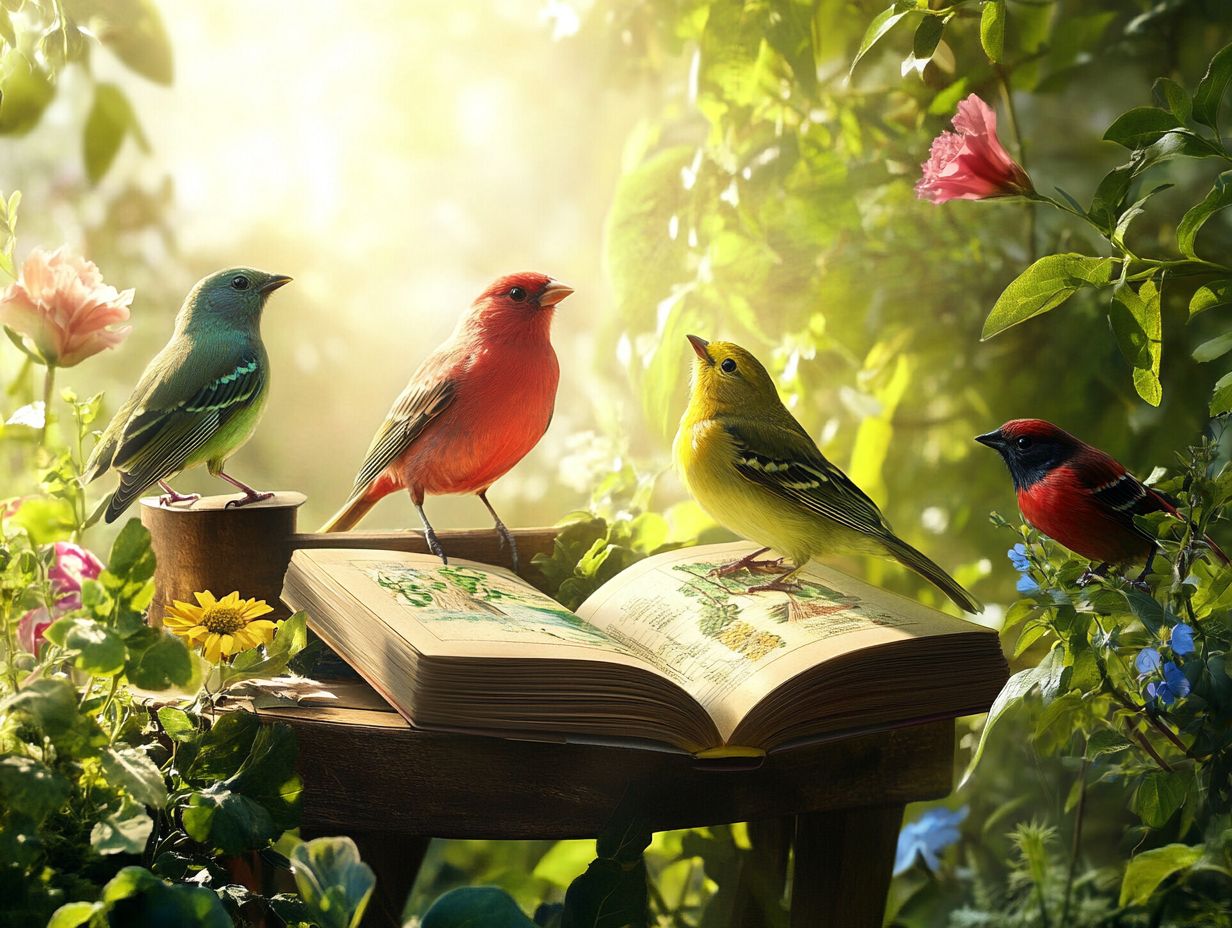
What are field guides for attracting backyard birds?
Field guides for attracting backyard birds are resources that provide information on how to attract birds to your backyard. For example, Field Guides: Navigating the World of Birds typically include details on bird behavior, feeding preferences, and habitat requirements.
Why should I use a field guide for attracting backyard birds?
Field guides can help you create a bird-friendly environment in your backyard. By understanding the needs and behaviors of different bird species, you can attract a wider variety of birds and provide them with a safe habitat. For beginners, a great resource is the Field Guides: A Beginner’s Companion to Birding.
What should I look for in a field guide for attracting backyard birds?
When choosing a field guide, look for one specific to your geographic region. It should include information on different bird species, their physical characteristics, and their preferred foods and habitats, such as those found in Field Guides: The Art of Birdwatching Simplified.
How can I use a field guide to attract specific bird species to my backyard?
A field guide provides valuable information on the specific needs of different bird species. For example, if you want to attract hummingbirds, you can learn about their preferred flowers and nectar feeders.
Are there any other resources I can use in addition to a field guide for attracting backyard birds?
Yes, there are many other resources, including online forums, birding clubs, and local birding experts. You can also attend workshops or events focused on backyard birding to learn more tips and tricks.
Do I need a lot of experience to use a field guide for attracting backyard birds?
No, you do not need a lot of experience. These guides, such as a beginner’s guide to birdwatching, are user-friendly and provide information for birders of all levels. With some basic knowledge and a willingness to learn, you can attract birds to your backyard.

